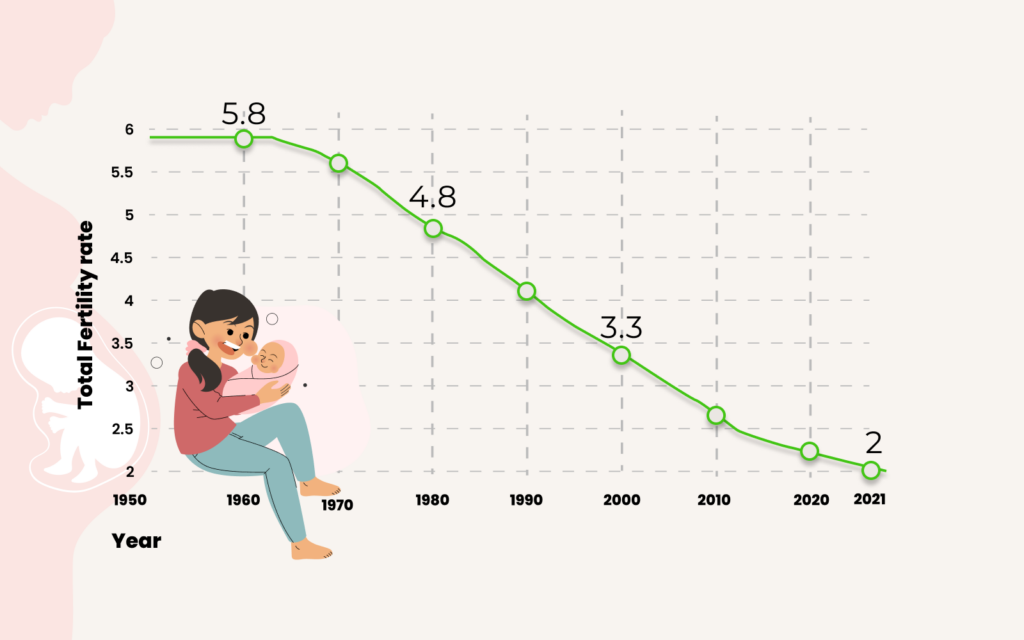This post has been authored by Kamraan Hafeez, an Economic Analyst Intern at Arthashastra Intelligence.
There have been many discussions going on in the internet after the release of fertility data about the future of India\’s population. The data released by the sample registration system points at some of the important findings. Let’s analyse this with the help of data.
According to the UN Population Division, Total fertility rate (the number of children that would be born to a woman over her lifetime) of about 2.1 children per woman is called replacement-level fertility. If replacement level fertility is sustained over a sufficiently long period, each generation will exactly replace itself.
India in 1952 adopted an official policy towards population stabilization known as the National Family Welfare Programme with the objective of \”reducing birth rate to the extent necessary to stabilise the population at a level consistent with requirement of national economy. It is difficult to comment on the extent of its success but it did in fact start a decreasing trend of TFR from 1965.
In 1950 the total fertility rate was 5.9 which in 2021 decreased to 2 children per woman.
Initially, India experienced a high fertility rate, the major motivating factors were:
- Dependence on agriculture – Majority of the population in India is dependent on agriculture, more the no of hands the better.
- Less expensive to breed children – Earlier the money spent on a child upbringing was very low
- Lack of female education- Lack of female education and women being married at a very young age were the major contributing factors that led her to be dependent on the male counterpart.
- Preference for a male child – People took chances to be blessed by a son as families without a son were looked down in society.
- High infant mortality – Initially the infant mortality rate that is the no of infants death for every 1000 live birth was very high (190 infant death per 1000 live birth in 1950) this encouraged couples to have more children to increase their survival rates.
After experiencing a somewhat constant fertility rate from 1950 (5.9) to around 1965 (5.8), the fertility rate has been declining, the major factors:-
- Desire for a planned family- In India many young couples are planning before having a baby by taking into account various social, economic, financial factors
- High living standard – Income is considered to have a negative relation on the Total Fertility Rate. A rise in income levels is accompanied by a decrease in TFR
- Urbanisation- in urban residences the cost of raising children is high. Urban housing is comparatively more expensive, and children are probably less valuable to the urban household when compared to rural areas.
- Education among women -An analysis of NFHS 4 data suggests that education has a negative impact on TFR: as the level of education increases, the TFR decreases. The highest TFR was observed in women who do not have schooling (3.06 children per woman), while the lowest was reported in women having 12 or more years of education (1.71 children per woman).
India has seen a fair share of variation when it comes to the fertility rate over the years. According to National Family Health Survey -5(2019-21) India Fact Sheet, at present the TFR is 2 which is below the replacement level. India for the first time could consider itself in a position in which the population might fall, as opposed to the exponential growth. Although the population won\’t fall immediately, it’s still an encouraging sign from what we were earlier. But even after reaching this target, there is one more issue which is the huge variation of TFR amongst the states ranging from 3.0 children per woman in Bihar to 1.1 children per woman in Sikkim.
References
- Fertility rate: \’Jaw-dropping\’ global crash in children being born By James Gallagher 15 July 2020
- Census of India
- National Family Health Survey – 5 (2019-21) India Fact Sheet
- https://www.indiatoday.in/india/story/india-fertilitaty-rate-declines-replacement-level-meaning-nfhs-survey-1880894-2021-11-25

